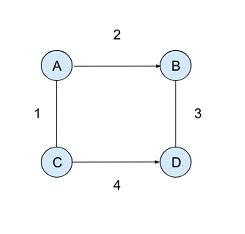
 Data Structure
Data Structure Networking
Networking RDBMS
RDBMS Operating System
Operating System Java
Java MS Excel
MS Excel iOS
iOS HTML
HTML CSS
CSS Android
Android Python
Python C Programming
C Programming C++
C++ C#
C# MongoDB
MongoDB MySQL
MySQL Javascript
Javascript PHP
PHP
- Selected Reading
- UPSC IAS Exams Notes
- Developer's Best Practices
- Questions and Answers
- Effective Resume Writing
- HR Interview Questions
- Computer Glossary
- Who is Who
Difference between Minimum Spanning Tree and Shortest Path
Introduction
The Minimum Spanning tree and the shortest tree plays a vital role in the field of graph theory to design the networks. While they share similarities as fundamental concepts, their purposes diverge significantly. In this article, we will dive into these two interesting elements within graphs and highlight their differences. MSTs aim at establishing minimal-cost connectivity among all vertices of a graph without loops, while shortest paths target identifying optimal routes between specific nodes in terms of distance or weight accumulation.
Difference between Minimum Spanning Tree and shortest Path
Graph theory offers various tools for analyzing connections and pathways within networks efficiently. While Minimum Spanning Trees and Shortest Paths may seem similar due to their focus on optimization, they serve distinct purposes in different scenarios. Let's take a simple example spanning tree graph,

Minimum Spanning Tree
A minimum spanning tree is defined as a subgraph that encompasses all vertices of an undirected, weighted graph with minimal total edge weight. The primary objective behind constructing an MST is to connect all nodes while minimizing the overall cost or distance between them.
To create an MST, various algorithms such as Kruskal's algorithm or Prim's algorithm are employed. These algorithms traverse through each vertex until every node is connected using edges with the least possible weights, resulting in a tree-like structure without any cycles. One prominent real-life application of MSTs lies within communication networks like telecommunication or power distribution systems; it helps establish efficient connections at minimal costs by eliminating unnecessary links that might lead to extra expenses in terms of resources and maintenance.
For instance, let us consider a simple scenario where we aim to establish power connections amongst various buildings in a city. Each building is represented by a node in our graph, and connecting them requires laying cables. To minimize costs, we employ algorithms like Kruskal's or Prim's to identify the minimum spanning tree, which will represent the most efficient network design for connecting all buildings while minimizing cable usage.
Shortest Path
Unlike MSTs which focus on connecting all vertices efficiently while minimizing total weight, shortest path algorithms identify the most optimal path between two specific vertices based on some metric such as length or time duration. The shortest path provides us with detailed navigation instructions to get from point A to point B via multiple intermediary nodes if necessary. Dijkstra's algorithm which is a classic example among several other techniques, essentially explores different potential paths repeatedly until it successfully determines the one with the lowest accumulated cost or weight for reaching a particular destination from a starting point.
The utilization of shortest paths spans diverse fields including transportation systems planning, routing protocols designed for computer networks, GPS navigation apps determining the fastest routes, supply chain optimization solutions that optimize the most efficient path for goods delivery, and even social network analysis measuring degrees of separation.
For instance, imagine we are using GPS navigation on our phone to find the quickest route from our current location (node A) to a desired destination (node B). The algorithm employed here could be Dijkstra's or Bellman-Ford's, which calculates shortest paths based on factors such as road lengths or average speeds. These algorithms enable us to pinpoint the fastest way to reach our destination, considering any intermediate stops or detours along the way.
Difference between Minimum Spanning Tree and Shortest Path
Basic Parameters |
Minimum Spanning Tree |
Shortest Path |
|---|---|---|
Definition |
A tree that spans all vertices, while minimizing total weight. |
The path with the lowest accumulated weight or distance. |
Main Objective |
Connecting all nodes together with minimal total weight. |
It finds the most efficient route between the specific routes. |
Key Property |
It contains no cycles or loops. |
Directed or undirected edges |
Algorithm Examples |
Some of the examples are Kruskal's and Prim's. |
Some examples are Dijkstra's and Bellman-Ford's. |
Advantages |
It is used for wide purposes like the network design for laying cables and also merges the data in unsupervised learning. |
The connection between the two points can be chosen very efficiently by the shortest path and it also helps the people in navigating the end location with minimal distance. |
Disadvantages |
When the network design is large, it becomes too tedious. |
It finds the shortest path, but it may not be a unique one. |
Conclusion
In summary, although both minimum spanning trees and shortest paths involve navigating through graphs and identifying optimal connections within networks, their goals significantly differ in terms of objectivity and purpose. While MSTs provide an economic means of achieving connectivity throughout a graph's constituent elements, shortest paths emphasize efficiency when traversing specific roads within the network?giving us invaluable insights into real-world scenarios where travel distances matter most.

